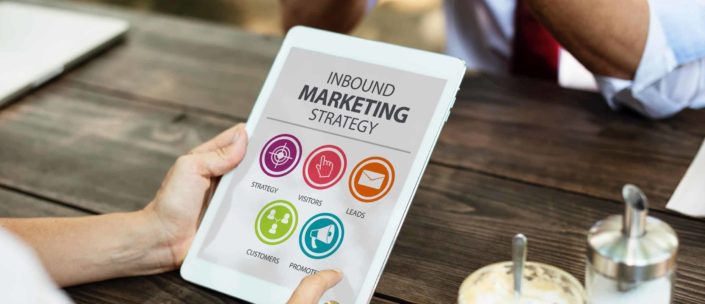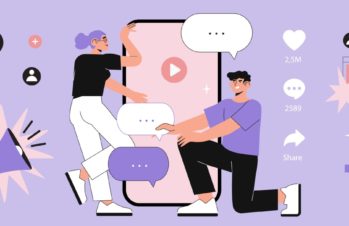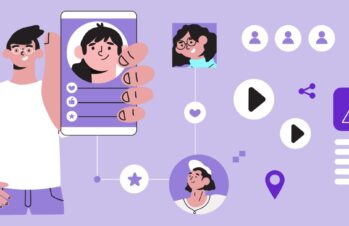The rise of the connected consumer as the new norm has caused a seismic shift in the marketing landscape, and the growth of influencer marketing has been one of the most visible changes. Gone are the days when the most effective strategy was to have a spokesperson, maybe a celebrity or subject-matter expert, represent your company in the mass media. Today’s consumer is skeptical toward messages that come directly from companies in the traditional manner, and much more likely to trust the word of an influencer, someone who affects the decisions of numerous people by posting content on social media. Influence marketing is far more personal than the old approach, and it operates on the mechanism of a trust already established.
The applications for B2C marketing are fairly obvious, but B2B influencer marketing operates a bit differently, and companies that neglect it or don’t use it optimally are missing out on vast opportunities to convert trust into engagement with their brands. With an authoritative individual or other business voicing your company’s merits on social media, you’re much more likely to foster a sense of brand-connectedness in the B2B space that generates leads and eventually sales.
When devising a B2B influencer marketing strategy, you should bear the following points in mind:
Businesses shop more deliberately than consumers.
In the B2C environment, sales often occur after only brief exposure to a product, with little or no research by the customer. It’s possible for one or a very few social media posts to generate significant business. For B2C companies and their social media strategies, even one powerful and compelling post could be enough to boost sales. Most B2B transactions revolve more around long-term goals and presuppose a certain amount of commitment, so the sales cycle tends to be longer. Potential B2B buyers routinely will make inquiries among their peers and perform extensive research, maybe even over a period of several months, before even making direct contact.
The B2B influencer is extremely important in this context because his or her social media presence can be a significant part of that research in addition to acting as a form of peer input. If your influencer is consistently putting your message out there and keeping it alive in the consciousness of the potential buyer, you’ll be in the picture when the time comes to make a purchasing decision.
IBM created a masterstroke of credible influencing with sustained content from a large aggregate of influencers who know its products best and can articulate their knowledge well: its employees. Considering the diversity of IBM’s clientele—financial services, banking, the tech industry, and all levels of education, among others—finding one team of influencers for across-the-board promotion was no small accomplishment, but encouraging employees to post on social media did the job. The company provided them with content as needed—and a caution is in order here: If the influencing looks too contrived, you can lose credibility. IBM apparently had just the right touch.
B2B influencer marketing differs from B2C in being more about educating your audience. The best advice we can give B2Bs is that your edge lies not in keeping your intellectual property under wraps but in out-educating your competitors.
Businesses usually respond better to a different kind of social content.
Another area in which businesses are generally unlike individual consumers is in the type of content they find persuasive. In the B2C environment, the interests and tastes of the everyday customer prevail. Lifestyle posts and humor may play a large role. With B2B, the decision-makers tend to be highly educated, tightly focused on the particular needs of the business, and characterized by the skepticism that naturally accompanies making a decision that could have long-term consequences in the workplace. A trusted third party—in other words, an influencer—is especially important to people in their position.
Amex looked at the concerns of small-business owners and astutely partnered with one of their peers—a peer with a large following. The Love My Store campaign was intended to help small businesses let their customers know they accepted Amex and featured Grace Bonney, a small-business owner whose daily blog, Design Sponge, has a monthly audience of more than 2 million. She created a series of highly artistic window stickers designed to appeal to small businesses, with another influencer, design blogger Emily Henderson, giving advice on how to use signage to attract new business. The result was 5 million impressions on social media.
One of the beauties of that campaign was that it did have an element of lightheartedness and lifestyle interest. B2B social media can be fun—a certain amount of liveliness and personality appeal is good—but whatever you do, you need to be sure you’re not distracted from the key point of explaining what makes you a leader in your field. Remember to educate.
Pure expertise means more in the B2B influencer space.
B2C influencer marketing often utilizes a prominent consumer or a local influencer who is geographically nearby or at least within your circle of followers and friends. B2B influencer marketing is more oriented toward the authority and authenticity inherent in someone who has definite, impressive expertise in your niche. If Joe or Jane Hollywood likes your product, that’s excellent but not especially relevant. You’d be infinitely better off with someone in corporate life who has purchased your product for an entire department or company, for instance. In the B2B world, influence comes from expertise.
Time Warner Business Class went that route by using video testimonials from customers among small and medium-sized businesses, including Spectrum Enterprise and Green Dot Public Schools. The videos praised Time Warner cable as essential to the success of those customers and were shared via YouTube, Facebook, and Twitter. Each ended with a call to action asking viewers to download an eBook titled Mighty Mid-Market, which provided more information about what Time Warner Business Class connectivity can do for businesses.
What to look for in an influencer.
We’ve established that expertise is paramount, but expertise doesn’t count if no one is paying attention. Reach is critical because you need to know how large a presence your influencer has across all social media channels and how many followers are out there expanding the exposure of a story.
Engagement also is crucial. An influencer who has a large social media community but who isn’t getting much engagement from viewers is less valuable in some contexts than one who has a smaller community but generates more responses. You have to decide which is most important in your situation: reach or engagement.
Relevance is another key consideration. Does a potential influencer post frequently and on topics relevant to your interests? A spectacular post on an occasional basis is inferior to having a steady stream of posts related to your field of business keeping your message fresh in a viewer’s consciousness.
In evaluating potential influencers, it can be highly useful to see who your customers are interacting with on social media. This can go a long distance toward establishing whether someone has the relevance and engagement you need.
What’s really wonderful is if other influencers are sharing or liking or commenting on your potential influencer’s activity. This type of activity can promote your story with exponential effect.
Hold onto your brand.
Don’t let the tail wag the dog. Although there might be times when you need to tailor your content specifically to the needs of your influencer, the objective should always be to build the brand you’ve already established. By all means, listen to your influencer’s expertise and learn from it where possible, but don’t allow an influencer relationship to cause deviation from brand values. Make sure those are clear from the very beginning, and partner with people who not only know about but care about the same things you do.
One of the beauties of social media, from a marketing perspective, is that the size of your reach and relevance and resonance don’t depend exclusively on the size of an advertising buy. The smallest company can exert a high impact—and maybe stop being small—by using influencer channels to connect with potential buyers.
Despite the differences between B2C and B2B influencer marketing, the core idea is the same: to build your efforts around the fact that people care more about what’s relevant to themselves than what’s relevant to your business, and that they respond best not to some faceless entity but to other people.







